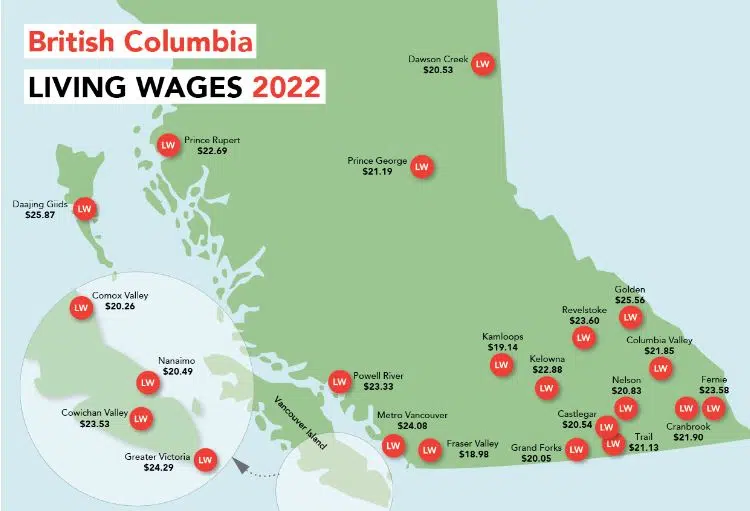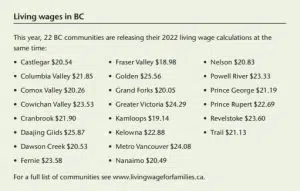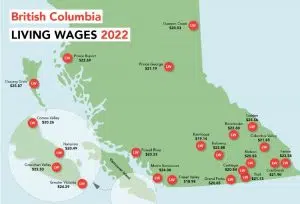
(Credit: Living Wage for Families BC)
According to a report, the 2022 living wage in Kamloops increased 14.5 per cent this year.
Driven by the 40-year inflation high and rising costs of living, the hourly wage to support a family of four in Kamloops is $19.14 an hour, compared to $16.71 last year.
The increase follows the same trend in British Columbia, as each of the 22 communities saw living wage increases caused by the rising costs of food and shelter.
The Fraser Valley had the lowest living wage at $18.98 an hour, while in Kelowna it sat at $22.88, which is $4.39 higher than last year.
Additionally, it’s the first time the living wage in Victoria is higher than in Metro Vancouver, to blame are the increased costs of food on Vancouver Island.
The living wage in Victoria this year is $24.29 an hour, up $3.79 from last year, while Metro Vancouver’s living wage sits at $24.08, an increase of $3.56 year over year.
With that, Living Wage for Families Provincial Manager Anastasia French says a major change this year is — food prices — which have bumped up to the second most expensive item in a family’s budget.
“Food has overtaken childcare as the second most expensive item in a family budget because the government has done an amazing job in investing in childcare and bringing down those costs,” she said.
“Normally, food increases by about one to two per cent, but this year, it has shot up. I think that comes as no surprise to anyone who goes to a grocery store because suddenly it is like, ‘What? how much is the lettuce now costing?'”
France says living wages are calculated in conjunction with communities across the province to determine the essentials in a family’s budget.
“The cost of renting somewhere, the cost of food, the cost of having and operating a used car, and having a transit pass, and taking all of the different essentials like childcare and putting it into a budget,” she said. “We then deduct a lot of government benefits that families receive, so the BC family benefit, Canada Child Benefit, and all of those things, to come out with the final amount.”
French says household debt, savings for retirement, and exotic vacations are not included in a living wage.
“It’s a barebones budget for what a family needs to get by.”
She adds the living wage is significantly different than the minimum wage, which currently sits at $15.65 an hour in BC.
“As you can see, there’s a $4 an hour gap there between what the legal minimum an employer must pay and what people need to be able to survive.”
French says their hope with this report, is to encourage employers to pay a living wage and advocate for government policy to make life more affordable.
For the next steps, French says she wants the government to figure out ways to make housing more affordable, by building affordable housing and looking at ways to tie rent to the unit, rather than to the tenant.
“If you’re staying in your apartment for a long time, your rent only goes up by one to 2 per cent every year because of rent control measures. But as soon as you move out if you either because your landlord evict you or because maybe you move to Kamloops because you’ve been given a new job or something like that, your rent is suddenly 10 to 20 per cent higher than it was before.”
More details on the 2022 BC Living Wage rates can be found here.

(Credit: Living Wage for Families BC)















